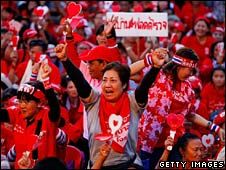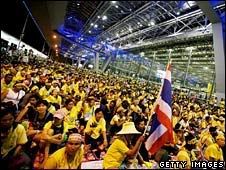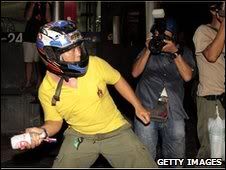

The red-shirts believe that the current government is illegal.The yellow-shirts say that they are defending the monarchy
Hundreds of riot police moved in front of a barricade erected by "red shirt" protesters in Bangkok's Silom business district early on Friday and told them to dismantle it, television said.
Television pictures then showed some protesters pouring what a TV reporter said was fuel onto the barricade, which is made up largely of tyres, with sharpened bamboo poles inserted.
A series of grenade blasts in that area killed at least three people late on Thursday. The government said the grenades were fired from the red shirt protest area. Leaders of the red shirts, who are demanding a new election, denied they were responsible
Click Continue Reading below for more News clipping about Thai Red shirt protests news.
THE YELLOW-SHIRTS


The yellow-shirts say that they are defending the monarchy
The focus of the yellow-shirts' campaign is also Thaksin Shinawatra - but they utterly oppose him.
The yellow-shirts were behind the street protests that led up to the military coup of September 2006 - and the ones two years later that forced Mr Thaksin's allies from power.
Called the Peoples' Alliance for Democracy (PAD), they are a loose grouping of royalists, businessmen and the urban middle class.
They are led by media mogul Sondhi Limthongkul and Chamlong Srimuang, a former general with close ties to the king's most senior adviser, Gen Prem Tinsulanonda.
In the months leading up to the 2006 coup, the yellow-shirts accused Mr Thaksin of corruption and abuse of power.
They also accused him of inadequate loyalty to the monarchy - and wear yellow because it is the king's colour.
Street protests in Bangkok attracted tens of thousands of people, shutting the capital down. Amid political deadlock, the military ousted Mr Thaksin.
There was calm for several months. But rumblings began when Mr Thaksin's allies won the post-coup elections in December 2007 and formed a government.
In May 2008 the yellow-shirts restarted their protests, arguing that the government was merely a proxy for Mr Thaksin.
They staged sit-ins at government offices and there were sporadic outbreaks of violence.
In late November they staged a week-long sit-in at Bangkok's two airports, shutting down air traffic and crippling the tourism industry.
These protests - combined with a court decision to ban the ruling party - left the Democrats in a position to form a coalition government.
The yellow-shirts had achieved their goal and they called off their protests.
They have, however, threatened to return. On 18 April 2010, a month after the red-shirts took over Bangkok, the yellows gave the government an ultimatum - remove them within a week or face new protests.
THE RED-SHIRTS

The red-shirts believe that the current government is illegal
The focus of many red-shirts' campaigning zeal is Thaksin Shinawatra, the prime minister ousted by the military in a September 2006 coup.
By then Mr Thaksin had governed Thailand for five years. He was very popular among the rural poor, because he initiated policies that benefited them, such as funding for health-care and education.
When elections were held 18 months after the coup, this rural support had not changed, even though Mr Thaksin was in overseas exile.
Voters from Thailand's north and north-east returned his allies to power, only to see the government fall to a series of opposition protests and court rulings.
So, in March 2009, the red-shirts came out on the streets of Bangkok. Their formal name is the United Front for Democracy Against Dictatorship (UDD).
Members are mainly rural workers from outside Bangkok. But the UDD ranks also include students and activists who see attempts by the urban and military elite to control Thai politics as a threat to democracy.
The red-shirts say the military ousted an elected government in 2006.
They believe that the court decision that forced Mr Thaksin's allies from power two years later came from a biased judiciary. They say the current government - led by the Democrats - came to power illegally.
The red-shirts feel patronised by the suggestion that rural voters only backed Mr Thaksin because he bribed them - and they deeply resent the fact that the voice he gave them in Thai society has been silenced.
They want fresh elections and some - but not all - want Mr Thaksin back.
Their protest began with a series of sit-ins outside government offices, but quickly escalated.
In April they forced the cancellation of a summit of the Association of South-East Asian Nations (Asean) after storming the summit venue in the seaside resort of Pattaya.
Violence then erupted in Bangkok. Clashes involving troops, protesters and Bangkok residents left at least two people dead and dozens hurt.
As troops massed, the red-shirts called off their protests. Leaders said they feared more loss of life.
But the anger that triggered their action had not gone away and in April 2010, they called fresh protests in Bangkok aimed at toppling the government.
They occupied Bangkok's historic and commercial districts and at one point stormed parliament, forcing MPs to flee. They also stormed a satellite transmission base, in a bid to restart a television station which had been shut down by the government.
The protests turned violent on 11 April, when at least four soldiers and 17 civilians were killed in clashes as the army tried to disperse the red-shirts.
The violence shocked the city - but the red-shirts say that they are not going home until parliament is dissolved.






0 comments:
Post a Comment